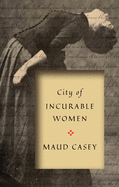
At just 128 pages, Maud Casey's compelling City of Incurable Women--ostensibly a historical novel featuring 19th-century French women institutionalized with diagnoses of hysteria--might invite an expeditious single-sitting read. That sparseness obscures its intricate density: hardly straightforward narrative, City of Incurable Women is a fascinating, multi-layered interaction between Casey's pithy words on the page and history's virtual elision of the titular "incurable women." Readers may well want side-by-side access to sources of additional information for a more satisfying, enhanced experience.
In 19th-century Paris, the Salpêtrière hospital was the domain of Jean-Martin Charcot, often called "The Father of Neurology." Casey opens her first chapter with a Charcot quote, almost as a warning epigraph: "The great asylum... contains a population of over 5,000 people, including a great number called incurables.... In other words, we are in possession of a kind of living pathological museum, the resources of which are considerable." Charcot's "Tuesday Lessons," a weekly public neurological demonstration displaying actual patients, were famed events. Four of Charcot's "best girls" take space here by name: "delicious" Augustine, committed at 15; stigmatic Louise, who bled every Friday; abandoned and abused Geneviève, who cut off her own left nipple; and "queen" Blanche, whose "death of [her] diagnosis" mysteriously (or not) coincided with Charcot's own passing.
"The doctors' stories have endings," Geneviève shrewdly comments. "My stories never finish." They also can't be complete since these stories exist only as other people's observations, research, records--and predominantly filtered through a limited, centuries-old male gaze. With acute empathy, Casey is here as witness and scribe. --Terry Hong, Smithsonian BookDragon

